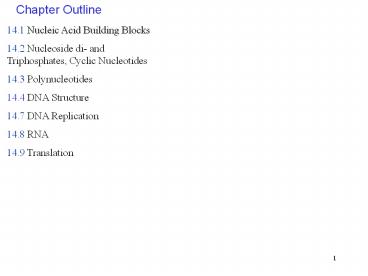Chapter Outline - PowerPoint PPT Presentation
Title:
Chapter Outline
Description:
... hydrogen bonding between the bases attached to the sugar-phosphate ... serves as a template for the manufacture of a new ... College Chemistry ... – PowerPoint PPT presentation
Number of Views:72
Avg rating:3.0/5.0
Title: Chapter Outline
1
Chapter Outline
14.1 Nucleic Acid Building Blocks 14.2 Nucleoside
di- and Triphosphates, Cyclic Nucleotides 14.3
Polynucleotides 14.4 DNA Structure 14.7 DNA
Replication 14.8 RNA 14.9 Translation
2
14.1 Nucleic Acid Building Blocks
- Nucleic acids consist of nucleotide residues.
- Each nucleotide is put together from three
building blocks - 1) phosphoric acid
- 2) a monosaccharide
- 3) an organic base
3
Two types of Bases
4
Nucleosides
A G C T In DNA
A G C U In RNA
4
5
Nucleotides
6
14.2 Nucleoside di- and Triphosphates, Cyclic
Nucleotides
7
Dinucleotides
8
14.3 Polynucleotides in DNA
8
9
Polynucleotides in RNA
9
10
The structure of DNA is understood in terms of
three levels of structure1) primary (sequence
of nucleotide residues)2) secondary3) tertiary
14.4 DNA Structure
10
11
Secondary Structure
- In DNA, secondary structure pertains to the helix
formed by the interaction of two DNA strands. - In the most commonly found form of DNA, two
single strands lie side by side in an
antiparallel arrangement, with one running 5 to
3 and the other running 3 to 5. - The two DNA strands are held to one another by
base pairing, hydrogen bonding between the bases
attached to the sugar-phosphate backbone. - This base pairing is complementary, which means
that A forms hydrogen bonds with T and G forms
hydrogen bonds with C.
11
12
12
13
Base Pairing
13
14
14
15
DNA Replication
- When DNA is replicated, each strand of the double
helix serves as a template for the manufacture of
a new strand of DNA. - In each of the daughter DNA strands, one strand
from the parent DNA is present. - This is called semiconservative replication.
15
16
16
17
- 14.8 RNA differs from DNA in that
- 1) It contains a different monosaccharide residue
- 2) It contains the bases A, G, C, and U instead
of A, G, C, and T - 3) It exists as a single strand instead of a
double strand
The first step in using the information stored
in DNA to produce proteins is transcription -
using DNA as a template to make RNA.
17
18
18
19
Three Types of RNA
- Transfer RNA (tRNA) are the smallest of the three
types (73-93 nucleotide residues), and they carry
the correct amino acid to the site of protein
synthesis. - Messenger RNA (mRNA) are of variable size,
depending on the protein to be manufactured, and
carry the information that specifies which
protein should be made. This message is carried
as a sequence of nucleotides that is
complementary to the template strand of DNA. - Ribosomal RNAs (rRNA) are relatively long RNA
strands (hundreds or thousands of nucleotide
residues) that combine with proteins to form
ribosomes, the multisubunit complexes in which
protein synthesis takes place.
19
20
20
21
14.9 Translation
21
22
22































